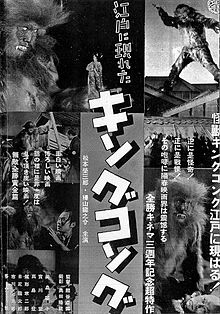King Kong Appears in Edo
King Kong Appears in Edo , Edo ni Arawareta Kingu Kongu? was a 1938 two part silent period piece drama film set during the Edo period and produced by Zensh Cinema. It is now considered to be a lost film.
This silent period piece drama film was produced in 1938 by Zensh Cinema. The film was broken into two parts. The first part called Edo ni Arawareta Kingu Kongu Henge no Maki King Kong Appears in Edo The Episode of the Monster was released on March 31, 1938, while the second part called Edo ni Arawareta Kingu Kongu gon no Maki King Kong Appears in Edo The Episode of Gold was released a week later on April 7, 1938. Both films ranreels in length and premiered at the Yrakukan theater in Asakusa, Tokyo. Going by the plot synopsis as well as flyers promoting the film, it is believed by historians that the ape looking more like a Yeti is only referred to as King Kong in name only, and does not appear gigantic outside of promotional photos that appear on the flyers and advertisements which depict him holding Chinami in the palm of his hand and straddling buildings as he faces down Hyoue Tobas men. This along with the fact that Zensho was a typical Poverty Row studio who didnt have sound recording equipment none of the 173 films they produced between 1936 and 1941 were talkies leads to believe that Zensho was simply trying to capitalize on King Kongs 1938 reissue in that country by promoting the ape as being a giant.However King Kong suit creator and actor Rynosuke Kabayama who later changed his name to Fuminori Ohashi and later created the ape creature seen in the 1956 film Mito Kmon Manyki Hitokui Hihi, as well as the suit for Godzilla in the original 1954 film stated in a 1988 interview The first model making to be counted as special art direction in Japanese cinema was a giant gorilla which I did for the movie King Kong Appears in Edo fifty years ago. It was also the first movie to feature certain kinds of special effects.. With this statement from the suits creator there seems to be some contradiction over the actual size of the title character. ........
Source: Wikipedia

